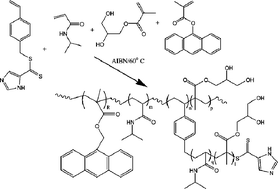Temperature-dependent phagocytosis of highly branched poly(N-isopropyl acrylamide-co-1,2 propandiol-3-methacrylate)s prepared by RAFT polymerization†
Abstract
Highly branched poly(N-isopropyl acrylamide-co-1,2 propandiol-3-methacrylate)s with imidazole end groups and containing anthramethyl methacrylate (AMMA) were prepared. The branch points were produced by incorporating a styryl dithioate ester (a RAFT monomer). The inclusion of AMMA ensures that the polymers fluoresce in the blue region so that they can be visualized in cells in culture. The feed composition was designed to provide lower critical solution temperatures (LCST) between 30 and 37 °C, and therefore the polymers are above the LCST at the usual temperature for culture of human cells. Inclusion of 1,2 propandiol-3-methacrylate (GMA) results in the formation of stable aggregates above the LCST rather than flocculated masses of polymer, and these colloidally stable sub-micron particles can undergo phagocytosis into human dermal fibroblasts. The phagocytosis is temperature dependant and does not occur below the LCST (at 30 °C) when the polymers are in the open-chain fully solvated and non-aggregated state.

- This article is part of the themed collection: Biomedical materials

 Please wait while we load your content...
Please wait while we load your content...